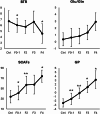A potential age-independent MASLD-related liver fibrosis index based on metabolic profiling
- PMID: 40897824
- PMCID: PMC12405442
- DOI: 10.1038/s41598-025-18172-x
A potential age-independent MASLD-related liver fibrosis index based on metabolic profiling
Abstract
The burden of metabolic dysfunction-associated steatotic liver disease (MASLD) is of immediate concern, as its prevalence is increasing worldwide. MASLD often progresses to liver fibrosis, posing significant health risks. Age-independent, noninvasive tools to evaluate fibrosis are needed to improve diagnostic accuracy across all age groups. Eighty-four inflammatory, hematological, and metabolic variables were quantified in the blood of 63 individuals with MASLD, with varying degrees of fibrosis, and 22 age-matched controls. Linear regression models were used to identify markers strongly correlated with liver fibrosis that were not influenced by age. Logistic regression models were used to evaluate the ability of various indices to discriminate between no/mild and severe liver fibrosis. Glutamine and propionate levels were identified as strongly correlated with fibrosis but not with age and were combined to form the GP index. The GP index demonstrated superior predictive power for liver fibrosis compared to existing scores, like FIB-4 and FIB-3. The study introduces the GP index, a novel metabolite-based score for diagnosing and monitoring liver fibrosis in patients with MASLD, which demonstrated robust performance irrespective of patient age in this cohort. By excluding age-dependent markers, the GP index can potentially reduce false positives and improve diagnostic accuracy, particularly in older populations. The combination of glutamine and propionate in this index represents a novel approach, capturing both intrinsic hepatic metabolic changes and extrinsic influences from the gut microbiota, providing a simple yet effective solution for liver fibrosis staging.
Keywords: Fibrosis; Glutamine; Glutaminolysis; Gut-liver axis; Metabolic associated steatotic liver disease; Propionate.
© 2025. The Author(s).
Conflict of interest statement
Declarations. Competing interests: The authors declare no competing interests.
Figures



References
-
- Rinella, M. E. et al. A multisociety Delphi consensus statement on new fatty liver disease nomenclature. J. Hepatol.79, 1542–1556 (2023). - PubMed
-
- Kong, D., Zhang, F., Zhang, Z., Lu, Y. & Zheng, S. Clearance of activated stellate cells for hepatic fibrosis regression: Molecular basis and translational potential. Biomed. Pharmacother.67, 246–250 (2013). - PubMed
-
- Tsochatzis, E. A., Bosch, J. & Burroughs, A. K. Liver cirrhosis. The Lancet383, 1749–1761 (2014). - PubMed
-
- Elena, P., Raluca Ioana, A., Andrei Emilian, P. & Adorata Elena, C. Non-invasive serological markers of hepatic fibrosis—mini review. Arch. Surge. Clin. Res.8, 032–038 (2024).
MeSH terms
Substances
Grants and funding
LinkOut - more resources
Full Text Sources
Medical

